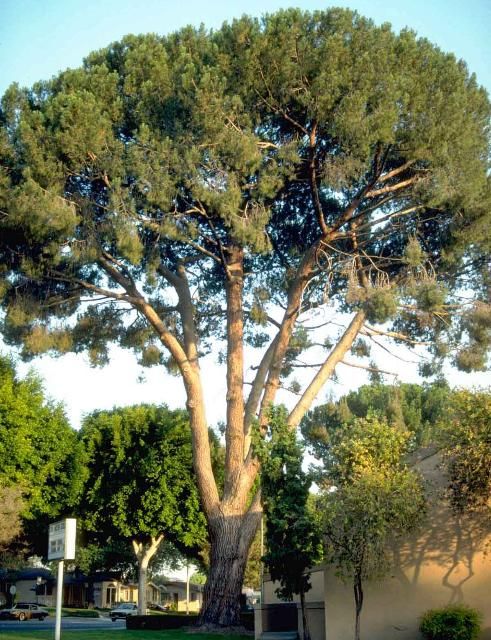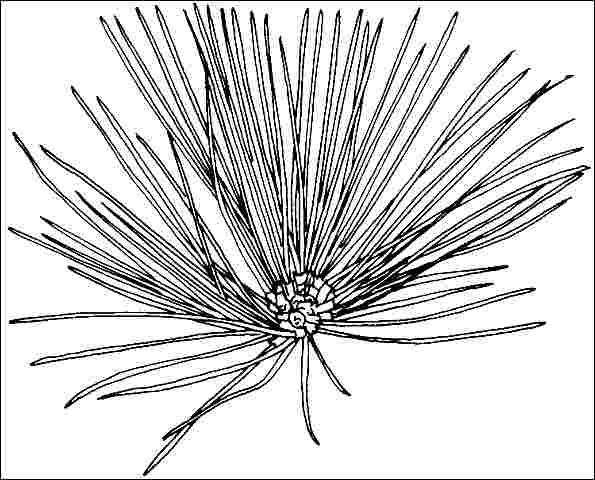Introduction
Just as its name implies, umbrella pine has a broad, somewhat flattened round canopy, and the tree will ultimately reach 80 to 100 feet in height though it is more often seen at 35 to 45 feet tall and wide. The bright green, stiff, six-inch-long needles are arranged in slightly twisted bundles, and are joined by the heavy, five to six-inch-long cones which remain tightly closed on the tree for three years. The trunk is showy with narrow, foot-long orange plates set off nicely by darker fissures.

Credit: Ed Gilman, UF/IFAS
General Information
Scientific name: Pinus pinea
Pronunciation: PIE-nus pie-NEE-uh
Common name(s): Stone pine, Italian stone pine, umbrella pine
Family: Pinaceae
USDA hardiness zones: 7A through 11 (Fig. 2)
Origin: not native to North America
Invasive potential: little invasive potential
Uses: fruit; screen; shade; specimen; parking lot island < 100 sq ft; parking lot island 100-200 sq ft; parking lot island > 200 sq ft; sidewalk cutout (tree pit); tree lawn 3-4 feet wide; tree lawn 4-6 feet wide; tree lawn > 6 ft wide; highway median; bonsai
Availability: somewhat available, may have to go out of the region to find the tree

Description
Height: 35 to 60 feet
Spread: 35 to 45 feet
Crown uniformity: symmetrical
Crown shape: vase, round
Crown density: dense
Growth rate: moderate
Texture: fine
Foliage
Leaf arrangement: alternate (Fig. 3)
Leaf type: simple
Leaf margin: entire
Leaf shape: needle-like (filiform)
Leaf venation: parallel
Leaf type and persistence: needled evergreen, evergreen, fragrant
Leaf blade length: 2 to 4 inches
Leaf color: green
Fall color: no color change
Fall characteristic: not showy

Flower
Flower color: yellow
Flower characteristics: not showy
Fruit
Fruit shape: oval, round, cone
Fruit length: 1 to 3 inches
Fruit covering: dry or hard
Fruit color: brown
Fruit characteristics: does not attract wildlife; showy; fruit/leaves a litter problem
Trunk and Branches
Trunk/bark/branches: branches don't droop; showy; typically one trunk; thorns
Pruning requirement: little required
Breakage: resistant
Current year twig color: brown
Current year twig thickness: thick
Wood specific gravity: unknown
Culture
Light requirement: full sun
Soil tolerances: clay; sand; loam; acidic; slightly alkaline; well-drained
Drought tolerance: high
Aerosol salt tolerance: high
Other
Roots: not a problem
Winter interest: no
Outstanding tree: no
Ozone sensitivity: unknown
Verticillium wilt susceptibility: resistant
Pest resistance: sensitive to pests/diseases
Use and Management
It is the seeds inside the cones which are of particular interest, called pignolia or pine nuts in the stores. The closed cones are gathered, then laid out in the direct sun which forces them to open so the seeds can be harvested. Eaten raw or roasted like peanuts, pignolia nuts are a traditional ingredient of certain Italian dishes. In fact, the tree is native to southwest Europe around the Mediterranean to Greece and Asia Minor, and remains of the cones have been discovered in Roman camps in Britain attesting to their long-time popularity.
Umbrella pine has not been extensively tried as a street tree except in parts on California where it has done well, but has the attributes of an urban tolerant tree. Drought and salt tolerance is high making it suited for areas such as western Texas and Olkahoma. Grows well in soil with a pH in the mid 7's or lower, but may do poorly with higher pH. Umbrella pine should be grown in full sun on well-drained soil. Winter winds and low temperature in USDA hardiness zone 7a cause needles to brown and they remain unsightly all winter.
Propagation is by seed.
Pests
There are a a large number of pests on pine.
Diseases
This tree is usually disease-free.
